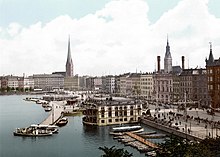Alster pavilion
The Alsterpavillon is a striking building in Hamburg that housed a traditional café in front of the current restaurant. The Alster pavilion is located on Jungfernstieg on the Inner Alster .
history

The first pavilion was opened on August 20, 1799 by the French Augustin Lancelot de Quatre Barbes. Two years later, in May 1801, the confectioner Richard Ruben from Graubünden became the operator. In 1809 he left the pavilion to his brother Donat Ruben, who ran it until his death in 1828.
Johannes Sprecher, who, like his predecessors, came from Switzerland, had a handsome pavilion built in the classical style in 1835. After his death in 1844, the pavilion was taken over by Spokesman's son-in-law Franz Dürst, and then from 1848 to 1874 by his son Heinrich Sprecher.
According to a design by the Hamburg architect Martin Haller , the tenant Johannes Schwarting had the existing pavilion rebuilt and expanded in 1874 and 1876.
Due to an extension of the Jungfernstieges, a new building was built in 1900 based on a design by Wilhelm Hauers . The massive building with polished granite columns and glazed Mettlach stones was nicknamed the "tiled stove".
On June 9, 1914, a new building designed by Hamburg architects Johann Gottlieb Rambatz and Wilhelm Jollasse was opened as the fifth building . During the Third Reich , swing concerts were held there for a long time , although music was frowned upon by the National Socialists . In 1942 the pavilion was destroyed during a bombing raid.
The semicircular sixth building with a flat roof that exists today was built in 1952–1953 according to plans by the architect Ferdinand Streb on the preserved basement and rebuilt in 1992–1994.
Swiss
pavilion In 1813, the French innkeeper Hyacinthe Dubernet received permission to lease the “Nilus” guard building, which had stood at Neuer Wall , as a second pavilion on the Alster. In 1815 Dubernet took on the leaseholder of the Alsterpavilion Richard Ruben as a partner. In the period that followed, their operators were also tenants of the so-called “Swiss pavilion”. During the great fire in Hamburg in May 1842, the building was destroyed and not rebuilt. In contrast to the Alster pavilion, which was popularly known at the time as the “smoke pavilion”, smoking was not permitted in the Swiss pavilion. Heinrich Heine visited the Swiss Pavilion regularly.
literature
- Carl Düsterdieck: 150 years of the Alsterpavillon on Jungfernstieg , Alsterpavillon Jepp, Hamburg, 1949
- The new Alster pavilion in Hamburg . In: Zentralblatt der Bauverwaltung . Vol. 34 (1914), No. 71, urn : nbn: de: kobv: 109-opus-48305 , pp. 509-511. (To the fifth building by Rambatz and Jollasse)
- NN: On the history of the Alster pavilion , in: Mitteilungen des Verein für Hamburgische Geschichte , 19th year 1898/99, Hamburg 1900, pp. 193–195, digitized
Web links
- ALEX Hamburg in the Alsterpavillon - website of the current operator
- Gisela Schütte: 200 years of the Alsterpavillon - the oasis in the heart of the city. In: The world. Axel Springer SE, August 3, 1999, accessed on June 6, 2018 .
- Olaf Wunder: Sensational photos When the Alsterpavillon was the most glamorous coffee house in Europe. In: Mopo Hamburger Morgenpost. Morgenpost Verlag GmbH, January 8, 2019, accessed on November 16, 2019 .
Individual evidence
- ↑ Another spelling: "Quatrebarbes", (Literature: P. Piper: Altona and the foreigners, especially the emigrants, a hundred years ago. Festschrift for the city anniversary on August 23, 1914, Harder Verlag, Altona 1914, p. 196. The dem French The Quatrebarbes family, members of the aristocracy, can be traced back to the 13th century.)
- ↑ a b [55] Alsterpavillon, conversions and additions, 1874 and 1876/78 , collaborators: Leopold Lambrecht in: Wilhelm Hornbostel, David Klemm (ed.): Martin Haller. Life and work 1835–1925. Dölling and Galitz Verlag, Hamburg 1999, ISBN 3-930802-71-6 , p. 228
- ^ F. Lange: Architecture in Hamburg. Hamburg 2008, object B 19.
- ^ Georg Nicolaus Bärmann: Hamburg and Hamburg's surroundings . A manual and auxiliary book for locals and foreigners, Friedrich Hermann Nestler, Hamburg 1822, p. 160, digitized
- ^ Heinrich Heine: From the memoirs of Herr von Schnabelewopski , Part One, at the beginning of Chapter 4.
Coordinates: 53 ° 33 ′ 14 " N , 9 ° 59 ′ 31" E



